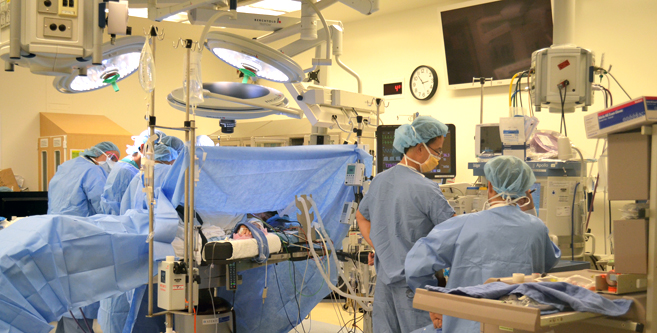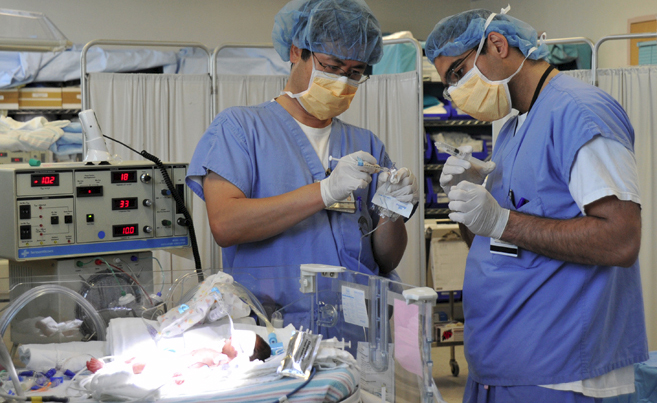
Residency
The program is primarily based out of Harbor-UCLA Medical Center, one of the largest medical centers within the Los Angeles County Healthcare System. The wide variety of patients and the varying degrees of acuity seen in our patients ensures an enriching and rewarding residency experience!

Rotations
Being only one of five level-one trauma hospitals in the Los Angeles County area, our cardiothoracic anesthesia service extends to trauma victims with blunt and/or penetrating chest injury as well. With board certification by the National Board of Echocardiography (NBE), members within our sub-specialty group are consultants in various areas. This has led to diagnostic echocardiography in all operating rooms, trauma surgical rooms, the endovascular surgical suite and the cardiothoracic ICU. Intraoperative TEE allows for diagnostic interpretation and aids in surgical management.
Each highly skilled faculty member teaches and trains residents during their CA-2 and CA-3 cardiothoracic anesthesia rotation. Numerous opportunities are available to improve knowledge and technical skills while all procedures (A-line, central line, PA catheters, double lumen endotracheal tubes, bronchial blockers, etc.) are performed under direct supervision. In addition, during the advanced CA-3 elective in perioperative transesophageal echocardiography, a one-month long dedicated time is spent on intraoperative TEE. Various opportunities are available for additional time in echocardiography laboratory as well.
Most residents rotate through the labor and delivery suite three times: 4-week rotations during the CA-1 and CA-2 year, and a 2-week rotation during the CA-3 year. The residents care for all patients on the Labor and Delivery floor, including the most complex obstetric or medical cases, and perform consultations along with the attendings. Our residents receive extensive experience in the care of clinically challenging patients.
The Division of Obstetric Anesthesia provides residency training in state of the art techniques and strategies of labor analgesia and obstetric anesthesia. Approximately 90% of the cesarean sections are performed using regional anesthesia. A variety of techniques of regional analgesia for labor are utilized, including epidural, spinal, and combined spinal epidural (CSE), and there is extensive use of patient controlled epidural analgesia (PCEA) for labor.
In our teaching and practice we try to emphasize and optimize not only the medical and technical aspects of anesthesia care, but also the interpersonal and organizational aspects as well. The Division of Obstetric Anesthesia has an active didactic teaching program for the Residents, with daily and extensive discussion of topics. A syllabus of topics covered during the rotation is given to each resident, along with a variety of other recommended reading materials. When residents on the rotation are senior residents, teachings are geared toward more advanced and/or research topics.
The vast patient diversity affords exposure to a wide variety of pain issues that will allow the residents to develop the competencies and skills needed to respond to the dynamic health care needs of patients across cultural and socioeconomic boundaries and integrate pain treatment with primary disease management. Our program prepares our residents for future practice in any setting. The training will involve all aspects of diagnostic and interventional pain management techniques along with utilization of consultative services.
The service works closely with the department of anesthesiology as well as with other surgical and medical divisions throughout the greater Los Angeles area, in order to provide excellent care in both an acute pain as well as chronic pain setting. Residents on the service will be introduced to various moralities of pain management, including medication management, fluoroscopically and ultrasound guided interventional treatments as well as neuro-axial and peripheral nerve catheter placement techniques.
During the CA-1 year, residents will be introduced to these age groups, with opportunities to care for children presenting for outpatient and inpatient procedures performed by pediatric surgeons, as well as orthopedic, ophthalmologic, otolaryngologic, and urologic subspecialists.
During the CA-2 year, residents will rotate for 2 months at Children’s Hospital Los Angeles (CHLA), and experience the anesthetic management of pediatric patients in that unique setting. After the CHLA rotation, CA-2 and CA-3 residents will be assigned to high-risk neonatal and pediatric patients at Harbor-UCLA Medical Center, including those with patent ductus arteriosus, necrotizing enterocolitis, other neonatal emergencies, airway anomalies, and complex neurosurgical issues.
During the CA-3 year, residents can elect to undergo another 1-month rotation at CHLA in order to reinforce the competencies required to become a successful pediatric anesthesiologist upon graduation. CA-3 residents also undertake a 1-month cardiothoracic rotation at Cedars-Sinai Medical Center, gaining more exposure to the field.
Many surgeons prefer the apparent advantages of peripheral nerve blocks including reduction of the incidence of deep vein thrombosis, early patient ambulation, better perioperative pain control, decreased incidence of PONV, in addition to better patient satisfaction. At Harbor-UCLA, we have a dedicated team consisting of a supervising attending physician, a regional fellow, and a rotating resident.
Rotations usually last for one-month at time, or a minimum of two weeks in a continuous period. In the months when a resident is not assigned, another resident will fill the position based on his or her availability and the OR schedule. We coordinate very closely with various surgical teams in order to provide quality care in a timely manner. The vast majority of the peripheral nerve blocks are performed under ultrasound guidance, and on occasion nerve stimulation techniques are also employed.
